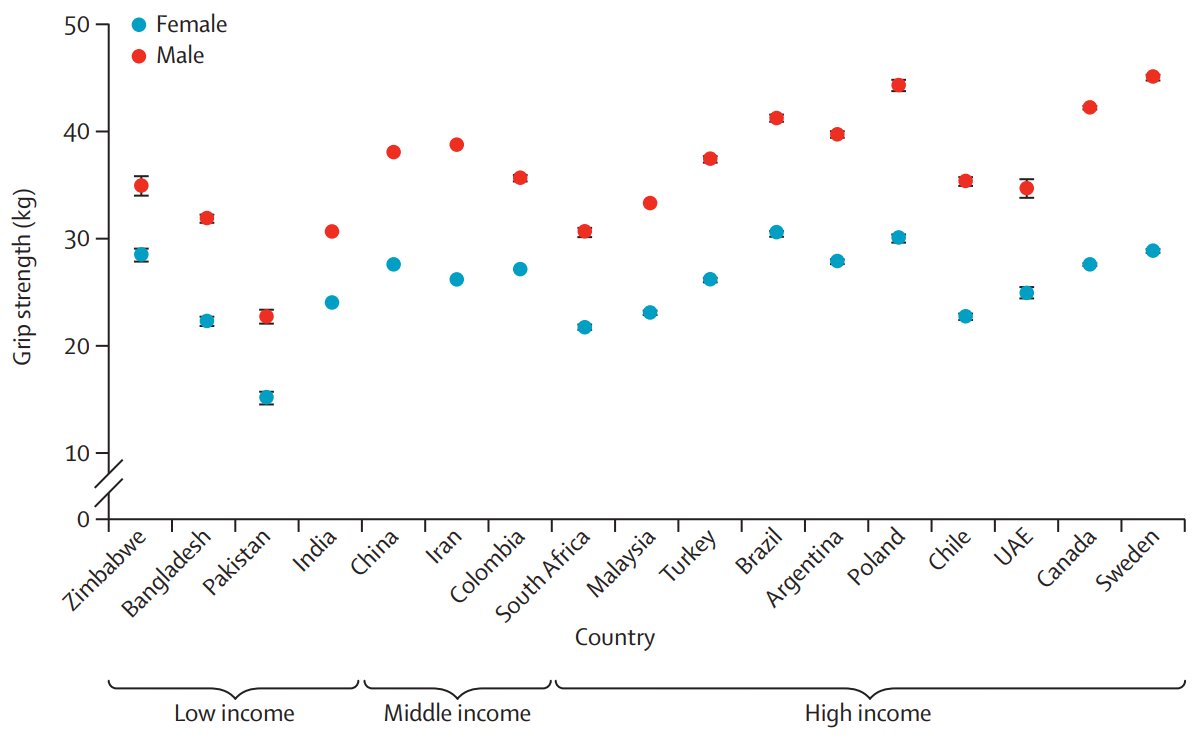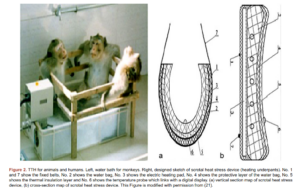Hand grip strength is a pretty interesting measurement. Fast to do, reliable, and seemingly irrelevant to most of modern life devoid of physical labor. But it turns out to be a rather decent proxy of health status. For instance this Japanese study:
Methods
A total of 4912 persons (1695 men and 3217 women), 35 to 74 years old at baseline, were the subjects of this study. Members of the Adult Health Study (AHS) cohort in Hiroshima, Japan, these individuals underwent a battery of physiological tests, including handgrip-strength testing, between July 1970 and June 1972. Mortality was followed until the end of 1999. Estimates of relative risk (RR) of mortality associated with grip strength were adjusted for potentially confounding factors by Cox proportional hazard analysis.
ResultsMultivariate-adjusted RR of all causes of death, except for external causes, for the highest quintile of grip strength in men was 0.52 (95% confidence interval [CI], 0.33-0.80) for the age group 35-54 years, 0.72 (95% CI, 0.53-0.98) for the ages 55-64 years, and 0.67 (95% CI, 0.49-0.91) for the ages 65-74 years. These figures were significantly lower than the RR for the reference group (the third quintile). Similar trends were observed in women. Multivariate-adjusted RR of all causes of death except external causes for each 5-kg increment of grip strength was significantly low (RR: 0.89, 95% CI, 0.86-0.92 for men, RR: 0.87, 95% CI, 0.83-0.92 for women). Multivariate-adjusted RR for heart disease, stroke, and pneumonia in men was 0.85 (95% CI, 0.79-0.93), 0.90 (95% CI, 0.83-0.99), and 0.85 (95% CI, 0.75-0.98), respectively. RR for each 5-kg increment of grip strength remained 0.92 (95% CI, 0.87-0.96), even after more than 20 years of follow-up.
ConclusionGrip strength is an accurate and consistent predictor of all causes of mortality in middle-aged and elderly persons.
Note that since grip strength was measured earlier in life, it isn’t just predictive of lifespan because old people who are about to die have weak hands, they also had weaker hands earlier in life. Does it work as an intervention? Probably not. We don’t really think that, causally, hand grip strength → lower mortality. We think that: hand grip strength ← general health → lower mortality. Buying a grip strength trainer probably won’t make you live longer.
Aside from the link to health, it is also linked to manliness. Men have much, much stronger hand grip strength than women. Here’s some American data from NHANES 2013, also split by race:

Combined grip strength (MGDCGSZ):
The combined grip strength was calculated as the sum of the largest reading from each hand, and expressed in kilogram. This variable was not calculated for participants who only performed the test on one hand.
Since this measurement has a true 0, I start the plot at 0 on the y-axis to make the proportions clearer. We see that while men are obviously much stronger — Cohen’s d = 2.38! — in percentage terms, men are only about 50% stronger:

There may be some racial variation in this difference, but it’s relatively small if it is real. (One could bootstrap these values to figure it out.)
The racial patterns inside the USA are also fairly unsurprising. However, one might think that these are just due to height differences, and maybe so for the sex difference as well. But that’s not true. It does relate to height, but they are substantial even if we adjust for height:

The gaps are smaller, especially for the Asians, but not gone.
Recently, I found this very interesting international study:

(They only used data from the dominant hand, not both as the US study did, that’s why the numbers are roughly halved.)
In this case, some of the same groups were measured but in their own countries. Now suddenly Africans are very weak compared to Europeans. Their ethnic version makes it easier to see:

If one had just seen this study one might mistakenly think that Europeans have a big genetic advantage in hand grip strength, whereas what actually appears to be the case is that between country environmental effects have a very large effect on this measure. This is interesting because the less developed countries actually use their hands a lot more for heavy work and thus have muscle training, but the other environmental effects between countries are just so much harder. Of course, we don’t know what these are, but probably something related to nutrition.
We see something similar for height within and between countries and their polygenic scores, but I will cover this in a future post because we are doing a study on it at the moment. Stay tuned. :)
